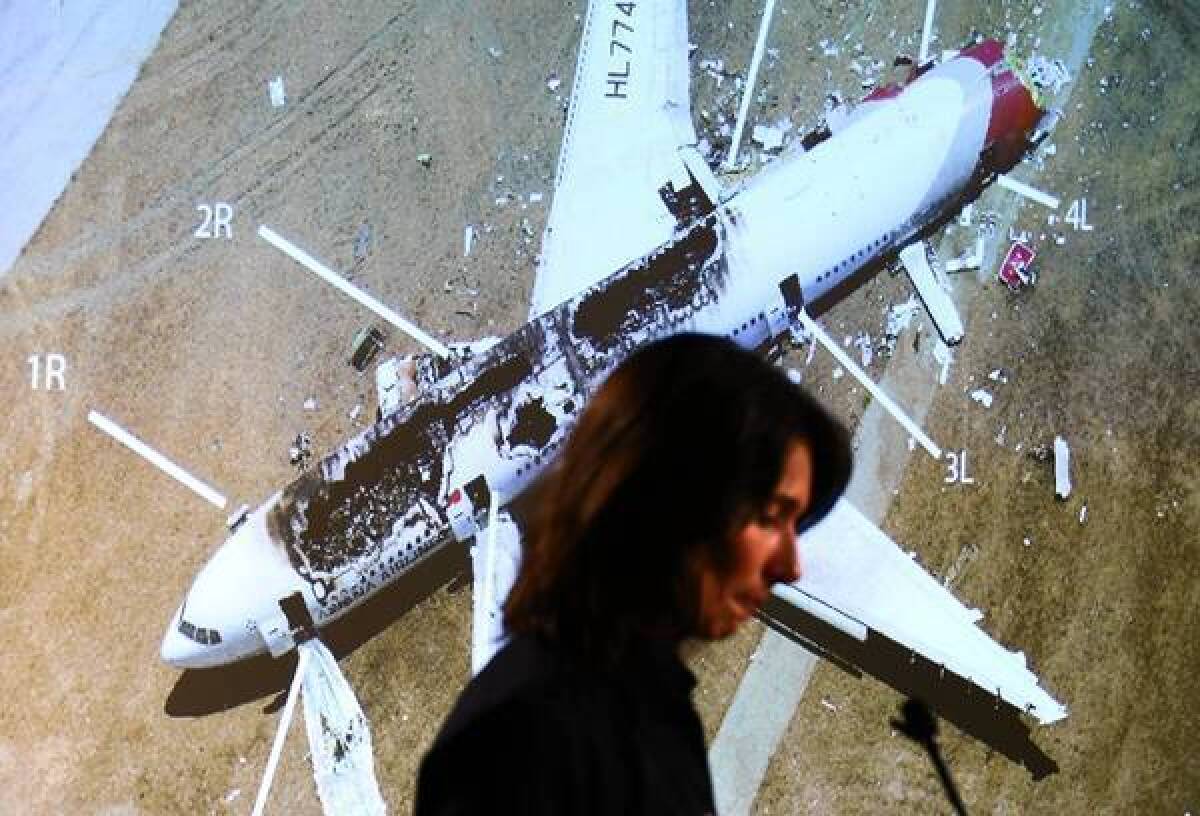Asiana plane’s automated cockpit tools were working, NTSB says

- Share via
SAN FRANCISCO — The automated controls that should have assisted Asiana Airlines pilots with their landing at San Francisco International Airport seemed to be working normally when the jetliner slammed into a seawall and runway, federal investigators said Thursday.
A preliminary investigation into cockpit tools that help pilots set minimum speed and altitude showed “no anomalous behavior,” said Deborah A.P. Hersman, chairwoman of the National Transportation Safety Board.
The NTSB’s updated information provides a more detailed look inside the cockpit in the moments before the Boeing 777 crashed on Saturday. But it still does not resolve the central question: why the Boeing 777’s speed and altitude fell so far out of the normal range for landing before the crash, which killed two people and injured 182 others.
Investigators are finishing their work at Runway 28L but will continue to analyze pieces of the plane at the NTSB’s labs in Washington, D.C. A report that will officially determine the cause of the crash is expected in about a year. Cranes have removed much of the wreckage.
The pilots, who had been cleared for a manual landing at SFO, told investigators that they had set the plane’s automated throttle to maintain a speed of 137 knots during descent. At an altitude of about 200 feet, they said, they noticed their speed declining and tried to recalibrate, adding more power to the engines.
“There are expectations that the crew is monitoring speed on approach,” Hersman said.
Investigators said the throttles had been set in several different “modes” in the minutes before the crash, possibly to execute angles and speeds dictated by air traffic control. However, there are some modes for which the auto-throttle on the Boeing 777 does not work to maintain speed.
Hersman said Thursday that crew members said two other times that the plane was coming in too slowly and too low. Initial reports had indicated only one call was made, about 1.5 seconds before the crash, to abort the landing and try again; a different crew member also called to abort the landing about three or four seconds before impact.
The plane’s relief pilot also commented on the plane’s sink rate, or descent over time, before the cockpit began making adjustments, Hersman said.
The pilot flying the plane, Lee Kang-kook, a veteran who was training on the Boeing 777, initially told the Korean media that he had been temporarily blinded by a bright flash of light just before the landing. That light source did not affect his vision, Hersman said, and seemed to be a reflection of the sun. Lee could still see the flight control instruments; the two other pilots in the cockpit did not mention the light.
The damaged runway could reopen as early as Sunday after some segments are repaved and repainted. The instrument landing system, which helps pilots navigate to the runway, will be closed until August as pre-scheduled construction on the runways continues.
As a foreign airline, Asiana is not subject to the same Federal Aviation Administration checks as U.S. carriers, Hersman said, but it still undergoes spot “ramp checks.” Officials examine clearly visible issues such as balding tires, as well as the status of the flight crew and the plane.
“They have been a quiet operator with no significant issues,” Hersman said, citing an interview with the FAA inspector who helps to oversee Asiana. In the last 18 months, FAA investigators have contacted Asiana 134 times.
Evacuation began about 90 seconds after the plane stopped moving, when a senior flight attendant spotted flames on the right side. Flight attendants initially told passengers to remain seated after the crash while the cockpit communicated with air traffic control. The tower called for emergency assistance before the cockpit called in, Hersman said.
Hersman said Wednesday that the first firetruck arrived two minutes after the crash and began spraying foam a minute later. But 911 tapes released by the California Highway Patrol indicate that some victims believed there were not enough medics or ambulances.
“There are a bunch of people who need help,” one woman told a dispatcher, adding that one victim had severe burns. “She’s really burned. She will probably die soon if she doesn’t get help.”
San Francisco Fire Department spokeswoman Mindy Talmadge said Thursday that fire personnel stationed at the airport were dispatched at 11:28 a.m., less than a minute after the crash. At 11:30 a.m., San Mateo County fire units were dispatched. At 11:34 a.m., American Medical Response ambulances from San Mateo County began to arrive. That same minute, SFFD units were dispatched from the city.
Frantic passengers who called 911 to say they could not see ambulances may not have realized that ambulances do not come onto the runway in an air crash but stage in a nearby area. Passengers are brought to them after triage.
First responders said that as they walked to the back of the plane, the damage to the seats and floors was progressively worse. When they reached the back doors, the floor was gone and the seats were heavily damaged.
The more than 300 seats in the main passenger cabin remained in the airplane after the crash, Hersman said. Flight attendants were some of the most severely injured victims: Three were ejected from the back area of the plane when the tail hit the seawall, and two others were trapped by evacuation slides that deployed inside the plane during the second impact, on the runway.
Nelson and Romney reported from San Francisco, and Mather from Los Angeles.
More to Read
Sign up for Essential California
The most important California stories and recommendations in your inbox every morning.
You may occasionally receive promotional content from the Los Angeles Times.
















